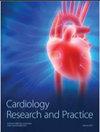Inhibiting H2AX Can Ameliorate Myocardial Ischemia/Reperfusion Injury by Regulating P53/JNK Signaling Pathway.
IF 1.8
4区 医学
Q3 CARDIAC & CARDIOVASCULAR SYSTEMS
引用次数: 0
Abstract
Myocardial ischemia-reperfusion (I/R) injury is a significant area of focus in cardiovascular disease research. I/R injury can increase intracellular oxidative stress, leading to DNA damage. H2AX plays a crucial role in DNA repair. This study utilized mouse and cell models of myocardial I/R to investigate the impact of H2AX on cardiomyocytes during I/R. This study initially assessed the expression of H2AX in MI/R mice compared to a sham surgery group. Subsequently, cardiac function, infarct area, and mitochondrial damage were evaluated after inhibiting H2AX in MI/R mice and a negative control group. Furthermore, the study delved into the molecular mechanisms by analyzing the expression of H2AX, P53, p-JNK, SHP2, p-SHP2, p-RAS, parkin, Drp1, Cyt-C, Caspase-3, and Caspase-8 in cardiomyocytes following the addition of JNK or P53 agonists. The results from western blotting in vivo indicated significantly higher H2AX expression in the MI/R group compared to the sham group. Inhibiting H2AX improved cardiac function, reduced myocardial infarct area, and mitigated mitochondrial damage in the MI/R group. In vitro experiments demonstrated that inhibiting H2AX could attenuate mitochondrial damage and apoptosis in myocardial cells by modulating the P53 and JNK signaling pathways. These findings suggested that inhibiting H2AX may alleviate myocardial I/R injury through the regulation of the P53/JNK pathway, highlighting H2AX as a potential target for the treatment of myocardial ischemia/reperfusion injury.抑制 H2AX 可通过调节 P53/JNK 信号通路改善心肌缺血再灌注损伤
心肌缺血再灌注(I/R)损伤是心血管疾病研究的一个重点领域。I/R 损伤可增加细胞内氧化应激,导致 DNA 损伤。H2AX 在 DNA 修复中起着至关重要的作用。本研究利用小鼠和细胞心肌I/R模型来研究I/R期间H2AX对心肌细胞的影响。与假手术组相比,本研究首先评估了心肌损伤/心肌梗死小鼠中 H2AX 的表达。随后,在抑制 MI/R 小鼠和阴性对照组的 H2AX 后,对心功能、梗塞面积和线粒体损伤进行了评估。此外,该研究还通过分析加入 JNK 或 P53 激动剂后心肌细胞中 H2AX、P53、p-JNK、SHP2、p-SHP2、p-RAS、p-Parkin、Drp1、Cyt-C、Caspase-3 和 Caspase-8 的表达情况,对分子机制进行了深入研究。体内 Western 印迹的结果表明,MI/R 组的 H2AX 表达明显高于假性组。抑制 H2AX 可改善 MI/R 组的心功能、缩小心肌梗死面积并减轻线粒体损伤。体外实验表明,抑制 H2AX 可通过调节 P53 和 JNK 信号通路,减轻线粒体损伤和心肌细胞凋亡。这些研究结果表明,抑制H2AX可通过调节P53/JNK通路减轻心肌缺血再灌注损伤,从而使H2AX成为治疗心肌缺血再灌注损伤的潜在靶点。
本文章由计算机程序翻译,如有差异,请以英文原文为准。
求助全文
约1分钟内获得全文
求助全文
来源期刊

Cardiology Research and Practice
Medicine-Cardiology and Cardiovascular Medicine
CiteScore
4.40
自引率
0.00%
发文量
64
审稿时长
13 weeks
期刊介绍:
Cardiology Research and Practice is a peer-reviewed, Open Access journal that publishes original research articles, review articles, and clinical studies that focus on the diagnosis and treatment of cardiovascular disease. The journal welcomes submissions related to systemic hypertension, arrhythmia, congestive heart failure, valvular heart disease, vascular disease, congenital heart disease, and cardiomyopathy.
 求助内容:
求助内容: 应助结果提醒方式:
应助结果提醒方式:


